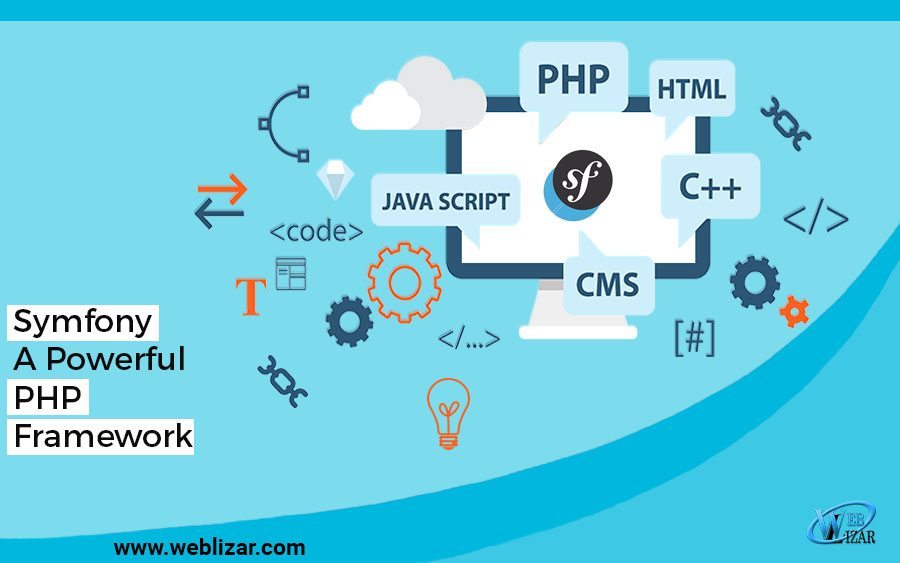PHP is the most popular server-side programming language to date. It is not just open-source but also rich in features and has all the functionality that paid scripting languages offer.
A PHP Framework is a basic platform, a collection of classes, which provides structure to develop web applications. PHP frameworks offer developers the ability to build more complex, secure, and well-rounded web applications faster than ever before.
Here’s a list of top PHP frameworks that are being used heavily these days.
In this post, we are going to talk about the Symfony framework. Symfony is an open-source MVC framework for rapidly developing modern web applications. Symfony is a full-stack web framework. It contains a set of reusable PHP components. Symfony is mainly inspired by Ruby on Rails, Django, and Spring web application frameworks.
Suggested Post: Top PHP Frameworks – Everything You Need To Know
Symfony has a well-organized structure, the clean code, which makes web development easier. Symfony is very flexible and used to build micro-sites and handle enterprise applications.
now let’s look into the features of Symfony that make it a popular framework among web developers:
-
- Microframework: Symfony can be used to develop a specific functionality. You don’t need to redevelop or install the entire framework.
-
- Flexibility: Programmers can easily extend all framework classes.
-
- Reduces development time overhead.
-
- Extremely mature templating engine and quickly delivers content to the users.
-
- Model-View-Controller based system
-
- Code reusable and easier to maintain
-
- Session management
-
- Full-featured database classes with support for several platforms
-
- Security against cross-site request forgery and other attacks
-
- Set of decoupled and reusable components
-
- High performance, due to bytecode caching
Also Read: Top PHP Frameworks – Everything You Need To Know
Symfony framework’s component can be used as a part of other applications like Laravel, Drupal, Joomla, etc.
Symfony Architecture:
Symfony is the collection of Components and Bundles. Components are parts of the Framework that handle a certain task. They can also be used without the Framework. In other words building blocks of a Symfony application. Components are a collection of classes providing a single core functionality. For example, the Cache component provides cache functionality, which can be added to any application. Symfony has several high-quality components, which are used in other top frameworks like Laravel.
Recommended Post: Top 10 PHP CMS
Bundles, a collection of code and other files written for use in a Symfony application. They are like plugins. A single bundle can use any number of Symfony components and also third-party components to provide features such as Web framework, database access, etc.
Symfony core web framework is a bundle called FrameworkBundle and there is a bundle called FrameworkExtraBundle, which provides more sophisticated options to write a web application.
Technologies that are using Symfony:
It includes famous CMS and e-commerce PHP frameworks. In CMS, Drupal, Joomla, Magento, eZ Publish, Typo3, Sulu, Bolt, and Page Kit are a few well-known names.
If we talk about PHP frameworks, Laravel is the most famous framework. Other frameworks are Lumen, Silex, Neos Flow, and the PPI framework.
Roadmap:
Symfony uses a time-based model to release its updates. A new version. the minor version comes in every six months, one releases in May and the other in November.
Symfony 3.3 is the current stable version and will be maintained up to July 2018. So according to the time-based model, Symfony is going to release its new version on November 30, 2017.
We will find many modifications in Symfony 4 like application Bundles being removed, the application directory structure being easier to navigate, config parameters are now environment variables, and many more. Symfony 4 will be more simple, easy to install, easy to configure, and easy to deploy.
The upgrading will be smooth, the current projects that want to upgrade to version 4, first must be upgraded to version 3.4, which provides total compatibility with any Symfony 3. x version. Then projects are ready to upgrade to Symfony 4.
Also Check Out: What is SASS (Syntactically Awesome Stylesheet)
Conclusion: Symfony PHP Framework
Symfony 3.3 is an amazing version with loads of features to use and ease things for a developer and Symfony 4.0 is ready to be launched on 30th November 2017. Make sure you are upgrading yourself with all the new and latest options Symfony 4 is offering. We’ll be covering a blog for the upcoming features of Symfony 4. Until then enjoy reading our blogs.

